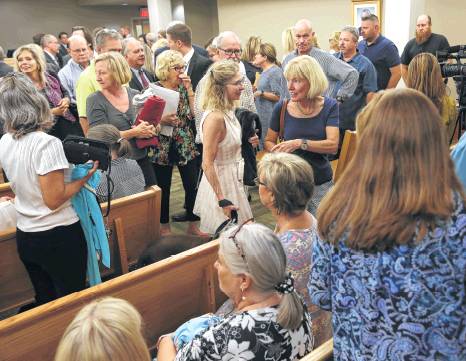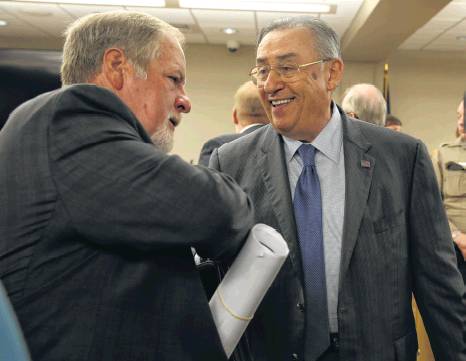Deal keeps four lakes intact for now
But recreation banned while experts determine if they’re safe
By Josh Baugh STAFF WRITER
SEGUIN — The Guadalupe-Blanco River Authority won’t drain its four remaining lakes on the Guadalupe River, but all recreation on the water will soon be banned, at least temporarily.
Those are the major terms of a legal settlement approved Monday by a judge and announced in a Guadalupe County courtroom teeming with property owners. The accord stipulates that lakes McQueeney, Placid, Meadow and Gonzales will stay full for at least the next year. But starting Thursday, no one will be allowed to use them for any reason.
The prohibited area — stretching from the dam at Dunlap to Gonzales County Road 143, a spot downriver from the Gonzales dam — will be monitored by law enforcement officers from the county and the state.
The ban will stay in effect until a three-member panel of experts determines whether it’s safe to reopen sections of the lakes. The panel will be formed soon, with the GBRA picking one expert and the property owners who sued the agency choosing another. Those two experts will pick the third member.
The panel will have 30 days to render its determination, though it may extend that to 60 days if necessary.
The settlement was forged on what was to be the second day of testimony in two lawsuits filed against the GBRA by more than 300 property owners around the lakes. The property owners challenged the legality of the GBRA’s decision to drain the lakes, a process that was to begin Monday with Lake Gonzales, followed by Meadow, Placid and McQueeney, which is the most populated.
The owners cited the likelihood of damage to their property values, businesses, houses, docks, wells and heritage cypress trees that grow along the shores of the lakes, formed by dams built about nine decades ago, if the lakes were drained.
The GBRA, which bought the dams in 1963, argued that the aging structures pose an imminent threat to people using the lakes because a spill gate could collapse at any time, as happened at Lake Wood in 2016 and Lake Dunlap in May.
A video of the Dunlap spill gate failure shows the 85-foot-long, 12-foot-tall mass of timber and steel breaking loose from the dam and lurching up and out before slamming down on the river below. The video also shows the impounded water rushing out.
No one was injured during either collapse.
Kevin Patteson, the GBRA’s general manager and CEO, said the agency recognizes the importance of the lakes to the residents and the surrounding communities.
“The fact that they were willing to come to the table with the expert panel and listen to those experts on what the safe zones are is something I’m happy about,” he said about the compromise. “At the end of the day, we want to keep people off the dams, both above and below, and we’ll implement whatever measures we can to do that.”
Kevin Skonnord, president of the Lake Placid property owners group and one of the 10 owners who sued the GBRA, said he was “extremely happy” with the agreement.
“I think we settled on something that is really fair and impartial, and puts a process to that going forward,” he said. “And more importantly, water is staying in the lakes.”
The settlement doesn’t end the legal battle but gives both sides some breathing room. Visiting Judge Stephen Ables issued a temporary injunction Monday but set Oct. 5, 2020, for a trial on the merits of the lawsuits.
The courtroom battle underscored the growing discord over the lakes. Friction between the GBRA and the property owners ratcheted up this summer when the agency began publicly discussing the possibility of draining the four lakes.
After the failure at Dunlap, the GBRA asked engineering firm Black & Veatch to extract and examine a hinge assembly from one of the two functioning spill gates remaining at Dunlap. The firm reported that of the three components that make up the assembly, one was “highly questionable for continued use” and another was “unacceptable for continued use.”
“Based on the age and exposure of these structures, there is little reason to expect all three critical components of any hinge assembly to be in fair condition and suitable for continued use,” the report said.
A month ago, GBRA officials announced that the lakes would be drained, starting Monday, and urged residents to start removing their watercraft.
Residents and business owners said they were taken aback by the agency’s inflexibility. They called draining the lakes an extreme reaction to the potential hazard and instead proposed more and better patrols of closed-off areas around the dams.
The GBRA said people continued to intrude on and around the dams regardless of the posted warnings, and it displayed surveillance videos on its website to prove it.
The property owners’ argument got a boost Wednesday when Judge Ables granted the plaintiffs’ request for a temporary order stopping the GBRA at least while the court proceeding continued this week.
Settlement talks began and continued into the weekend.
Outside the courtroom, Ricardo Cedillo, an attorney for the 10 property owners who sued, said his clients rejected from the outset any offer that began with, “We’re going to have to drain the lakes.”
The GBRA resisted.
“I said, ‘No, I have to have a temporary injunction that says the lakes are not going to get drained,’” Cedillo said. “We began the back-and-forth, and we got there. But it all began with their concession that they would not drain the lakes and have the consequences of that visited on this community.”
The property owners want the lakes to remain while they try to work on longer-term solutions to the problems with the dams.
The GBRA says its plans for rebuilding the six dams could cost as much as $180 million and take years to complete.
At Lake Dunlap, property owners have been working since the spill gate failure in May to create a special taxing district, known as a Water Control and Improvement District, to help pay for a project there. Lake associations representing residents of McQueeney and Placid are discussing their own plans for new taxing districts.
Such special districts can assess a property tax, the revenues of which would help pay to refurbish the dams. Residents would vote on the districts, possibly in the 2020 election.
As jubilant property owners left the courtroom Monday afternoon, they made plans to celebrate. Some were headed home for drinks; others would gather at a lake house for a party.
Some said they planned to get out on the water for the next 48 hours, before it becomes illegal to be there. jbaugh@express-news.net


